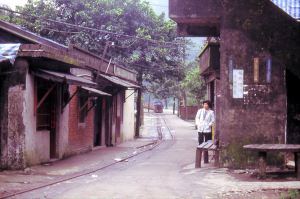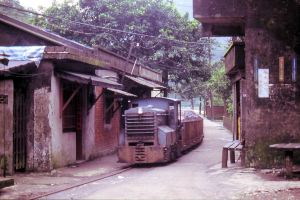‘Waiting for the train’

It’s March 1990 and behind the window of a train on its way to Hualien a small station called Houtung immediately draws my attention. First of all while a company called Taiyung Coalmine still is in full operation and in a glimpse a highly interested industrial railway reveals itself. Secondly while the place is decorated with many typical style Chinese lanterns for an outright friendly atmosphere. My thoughts are, okay, this will be the place to stay when I finished my rail tour around the isle.
A week later or so I left the train in the early evening, darkness all around. Houtung is situated in the mountains and down near the station, direct behind a tunnel entrance, there was nothing showing any activity others than the friendly red glow of the paper lamps. The main street is halfway a hill but also here no movements.
After walking around and dragging my luggage it appears to me that this was no village at all only a settlement for the workers of the coal digging company and of course no hotel or any other lodge. Here was a dilemma, what to do, waiting with my head on the bag in the open for the sunrise or find a place to stay in another village. The latter I found, on the other side of the tunnel, and called Juifang but not after I persuade some people in front of station to help me because there were no signs what so ever at least others than Chinese characters.
I am telling this only why I ended up in the filthiest room I have ever experienced in my whole life of travelling. A cheap Chinese hotel and looking back actually not inexpensive at all specially considering the comfort provided, or shall I say deprived of consolatory. Those kinds of rooms were you cannot permit to close your eyes afraid of fact that the mattress would walk away with you on top.
However, it suited for the time being and the day after I found a better lodge in the same small town. The ones where any foreigner is more than a stranger, a wonder about his whereabouts if there is a notion like that. Most Chinese do not show much signs of repentance or other interest and seems to be not aware of what happening around them unless you behave in a complete different manner.
Look again at the picture above, this is what I discovered by daylight, a grey forlornness resembling any east European country. It seems to be if the lady is waiting for the train at the town centre stop. In the distance he’s coming but as seen on the picture below not for passengers. On my request the lady stepped aside in order to make the picture pristine.
Industrial railway on a small scale, al long forgotten enterprise in the West. The East gives me a most warm welcome. In the end the twain meets.
Somewhere in the mountains there are mines and the narrow gauge (440 mm) is there to transport coal to a transhipment installation next to the tracks of the TRA (Taiwan Railway Administration) Here the dumping cars were emptied into cape gauge wagons (1067 mm) fur further transportation. Two lines existed; one in the valley beside a river and one on a higher level. As seen on the picture the valley line was a most peculiar industrial railway relict. A steep slope and the empty small dumping cars came down dangerously by gravity with a lot of noise. The brakeman on the last wagon let the rattling train stop where needed. Going upwards, trains were pulled by cable. The bridge behind the transhipment installation is for the uphill line.
An utterly joy for the moment and hardly believe in what have been discovered without any further notion. Only far away from anything familiar and not knowing if there ever will be another visit. It’s not easy to grab such a moment in full awareness because you’re still short of eyes to see what there is and trying capturing it on film. Baffled by the fact that someway or another time stands perfectly still.
The next visit came but seven years later and everything was gone. No more mining of the black gold, no longer any transhipments. Traces only, rusty memories and still vivid in my mind. By chance I found and what a change it was on two most remarkable days of my first Taiwan rail exploration.



These two posts are much appreciated, Robert. One really does need to get beyond the dubious delights of capital cities, tourist attractions and shopping opportunities. These remind me of my own life in a mining area.
Thank you, within a few days there will be a second story about this area with an even more spectacular transshipment installation. Not the place itself but the transportation of dumping cars over a river on a suspension bridge.
Hello, you may be interested in some old photos of this rail line that were printed in Life Magazine in 1949. (I think it is the same rail line). I posted a .txt link to the picture files on this page: http://taipics.com/pushcarts.php
(Its about pushcarts, but there are also some train pictures on the bottom of the .txt page including some bridge photos). I planned to add the links to the pushcart page, but just haven’t had time to do so yet.
Thanks for an interesting story on old Taiwan.
Thank you, good information, however, this is not the same bridge. On its height around 1933 there were 50 lines with this kind of system in the country with a total lenght of 1292 kilometre. The bridge at Shih Fen only serviced as a feeder from mine till transhipment installation.
My next story will be about the pushcarts and in particular the one surviving at Wulai.
Thanks for those Marc!
Some wonderfully atmospheric B&W pictures of human haulage roads from 1976:
http://www.kurogane-rail.jp/jinsha/ejs-idx.html
Even a silent color video:
http://www.kurogane-rail.jp/movie/emovie_wudu1.html
Wow, amazing links and video, GWR. I’ve been fascinated by the pushcart system here in Taiwan for years but never had the chance to see one in operation (besides the old tourist one in Wulai that takes you to the waterfall and cable car). Thank you for the links!
P.S., if interested in a few more human powered rail images from Taiwan, please visit the “sugar” page on taipics (links at bottom of page): http://taipics.com/sugar.php
A last follow up: (!) Upon digging around in the links that GWR provided, I believe the Life Mag photos of the bridge/train/carts (in the .txt link) are from the Keelung coal mining train. Here are two bridge pictures:
Life Mag: http://tinyurl.com/639ucxc
http://www.kurogane-rail.jp/wudu/ewudu2.html
Another very interesting link on the Kurogane-rail.jp site is the before/after photos of the Wudu coal railway: http://www.kurogane-rail.jp/wudu2/ewudu2-idx.html
I plan to do a hike around that area in the near future. As I think about it, it would be so cool if Taipei could somehow bring back one of the pushcart lines for tourists. Perhaps they can rebuild a small line between the Taipei City Hall MRT station and the “Warner Village” area. (its a long walk on a hot day). The pushcarts would be perfect as a “touristy” thing to do + be a way to employ a few students. – Just a thought anyway.